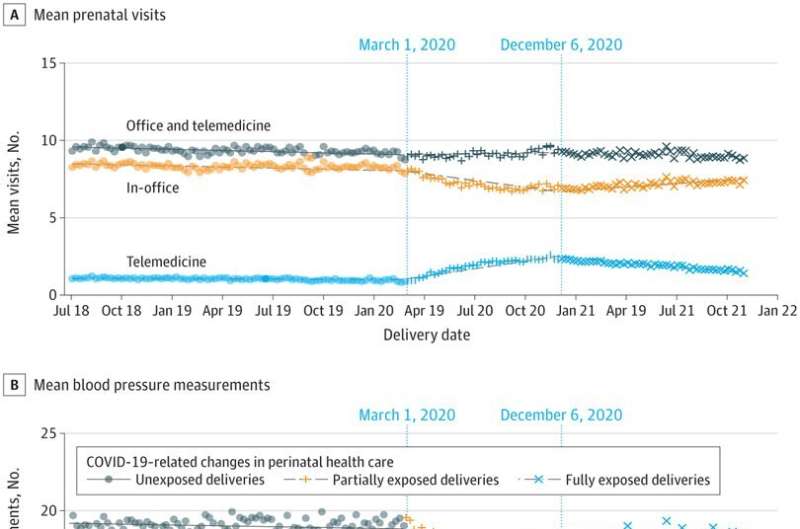This article has been reviewed according to Science X's editorial process and policies. Editors have highlighted the following attributes while ensuring the content's credibility:
fact-checked
peer-reviewed publication
trusted source
proofread
Study finds similar outcomes for in-person prenatal care or a combination of virtual and in-office visits

Pregnant patients who received some of their prenatal care during the COVID-19 pandemic in a combination of virtual and in-office visits—known as multimodal prenatal care—had similar health outcomes as those who were seen mostly in person before the pandemic, according to a large new study of more than 151,000 births from the Kaiser Permanente Division of Research.
The analysis compared pregnancy care, delivery, and outcomes for three different time periods: delivery before the pandemic (July 2018 to February 2020), early pandemic (March 2020 to December 2020), and mid-pandemic (December 2020 to October 2021). Rates of preeclampsia (a dangerous high-blood pressure condition in pregnancy), severe maternal morbidity, cesarean delivery, preterm birth, and admissions to the neonatal intensive care unit (NICU) did not change significantly among studied time periods.
The study also found no significant differences in the uptake of telehealth prenatal care among people from varying racial and ethnic groups or socioeconomic backgrounds, and those using a language other than English or living in a rural area. These findings address concerns that people who may have less access to technology for video care might have poorer health outcomes.
"The results suggest that remote care could have an ongoing role in replacing some prenatal in-person visits, increasing convenience for those who want to be seen at home, without harming disadvantaged people," said lead author Assiamira Ferrara, MD, Ph.D., a senior research scientist with the Division of Research.
"Integrating the use of telemedicine in prenatal health care provides an alternative to exclusive in-office care for people living in underserved areas or facing access barriers," Ferrara said. "Also, the latest guidelines for prenatal care suggest it is not necessary to be seen in person for every prenatal visit, and some care can be delivered effectively remotely."
The percentage of telemedicine visits for each patient jumped from 11% to 21% from the pre-pandemic period to the pandemic period. But the average number of prenatal visits per patient did not change significantly: it was 9.4 pre-pandemic and 9.15 in the pandemic period.
The specifics of prenatal care also did not change across the pandemic: blood pressure readings, gestational diabetes screenings, and depression screenings remained steady.
The work is published in the journal JAMA Network Open.
More information: Assiamira Ferrara et al, Prenatal Health Care Outcomes Before and During the COVID-19 Pandemic Among Pregnant Individuals and Their Newborns in an Integrated US Health System, JAMA Network Open (2023). DOI: 10.1001/jamanetworkopen.2023.24011




















